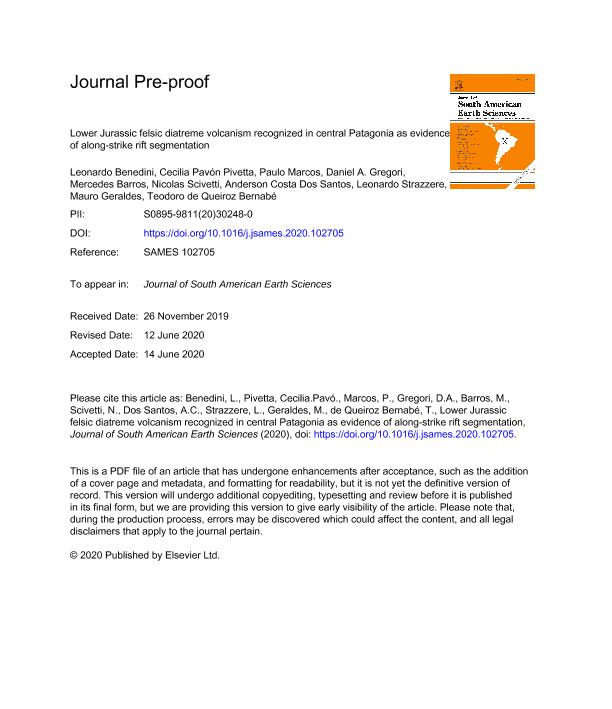Artículo
Lower Jurassic felsic diatreme volcanism recognized in central Patagonia as evidence of along-strike rift segmentation
Benedini, Leonardo ; Pavon Pivetta, Cecilia Mariana
; Pavon Pivetta, Cecilia Mariana ; Marcos, Paulo
; Marcos, Paulo ; Gregori, Daniel Alfredo
; Gregori, Daniel Alfredo ; Barros, Mercedes Virginia
; Barros, Mercedes Virginia ; Scivetti, Nicolás
; Scivetti, Nicolás ; Santos, Anderson Costa dos; Strazzere, Leonardo
; Santos, Anderson Costa dos; Strazzere, Leonardo ; Geraldes, Mauro; de Queiroz Bernabé, Teodoro
; Geraldes, Mauro; de Queiroz Bernabé, Teodoro
 ; Pavon Pivetta, Cecilia Mariana
; Pavon Pivetta, Cecilia Mariana ; Marcos, Paulo
; Marcos, Paulo ; Gregori, Daniel Alfredo
; Gregori, Daniel Alfredo ; Barros, Mercedes Virginia
; Barros, Mercedes Virginia ; Scivetti, Nicolás
; Scivetti, Nicolás ; Santos, Anderson Costa dos; Strazzere, Leonardo
; Santos, Anderson Costa dos; Strazzere, Leonardo ; Geraldes, Mauro; de Queiroz Bernabé, Teodoro
; Geraldes, Mauro; de Queiroz Bernabé, Teodoro
Fecha de publicación:
14/06/2020
Editorial:
Pergamon-Elsevier Science Ltd
Revista:
Journal of South American Earth Sciences
ISSN:
0895-9811
Idioma:
Inglés
Tipo de recurso:
Artículo publicado
Clasificación temática:
Resumen
The early Jurassic volcanism of Central Patagonia covers an extensive area of50,000 km2 where the volcanic deposits occur as isolated systems. The volcanicrecords form an elongated belt in which the composition, depositional and geneticfeatures, show several differences along with its distribution. The Cañadón ChilenoComplex (CCHC), located in the Río Negro province, provides the opportunity toevaluate and improve the knowledge about the Lower Jurassic volcanic stratigraphyand the lower Jurassic regional setting of Central Patagonia.Based on the field and laboratory data developed in the present work, 22lithofacies were recognized and grouped into eight facies associations. Thecontinental sedimentary environments include alluvial fan deposits (FA 1),ephemeral deposits (FA 2), braided fluvial deposits (FA 3), alluvial plains, or overbanks (FA 4), and lacustrine deposits (FA 9). On the other hand, the pyroclasticfacies were separated according to the pyroclastic currents involved during thedeposition; into fall-out, dilute, and density currents (FA 5, FA 6, and FA 7). Effusiveandesitic feeders and lava-flows (FA 8) were also recognized.The stratigraphic data obtained in the present work allow proposing theexistence of two felsic diatreme volcanoes in the CCHC records - described here asSouthern and Northern Zone-, developed over a local subsided area, represented byan asymmetrical basin.Seven units were recognized and described in the CCHC (Units a, b, c, d, e, f,and g: unit (a) represents an initial stage of continental sedimentation recordedthroughout the entire Complex. Unit (b) represents the upper felsic diatreme facies,in Southern Zone of the Complex, where debris flows are interbedded with massive lapilli-tuff deposits. Unit (c) consists of local andesitic lavas flows and feeder dikes,and the unit (d) consists of welded lapilli tuff deposits interpreted as the growth of thevolcanic system. The Northern Zone evolves similarly with the felsic intra-diatremedeposits of unit (e). The unit (f) consisting of an effusive stage represented byextended andesitic lava flows. Finally, a deep lacustrine system is installed (unit g)that includes shallow and deep facies, with intercalations of local pyroclasticdeposits.Also, new geochronological data (U-Pb zircon age of 188 ± 3 Ma) wasdetermined to confirm and reinforce the correlation criteria between the differentvolcanic areas in Central Patagonia, indicating that the volcanism described here issynchronous with the Northern silica-rich calderas of the Garamilla Formation as wellas the large andesitic volcanoes of the Lonco Trapial Formation located southwardto the CCHC. The regional volcanism changes described, in the present work, areconnected with the N-S rift segment limited by E-W regional transfer fault systemsdeveloped in continuity to the strike-slip structures of the La Esperanza area.
Palabras clave:
LOWER JURASSIC
,
FELSIC DIATREME VOLCANISM
,
PATAGONIA
,
RIFT SEGMENTATION
Archivos asociados
Licencia
Identificadores
Colecciones
Articulos(INGEOSUR)
Articulos de INST.GEOLOGICO DEL SUR
Articulos de INST.GEOLOGICO DEL SUR
Citación
Benedini, Leonardo; Pavon Pivetta, Cecilia Mariana; Marcos, Paulo; Gregori, Daniel Alfredo; Barros, Mercedes Virginia; et al.; Lower Jurassic felsic diatreme volcanism recognized in central Patagonia as evidence of along-strike rift segmentation; Pergamon-Elsevier Science Ltd; Journal of South American Earth Sciences; 14-6-2020
Compartir
Altmétricas



